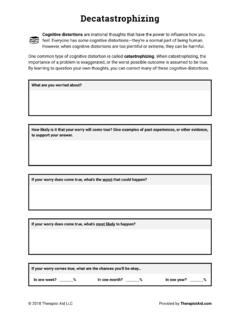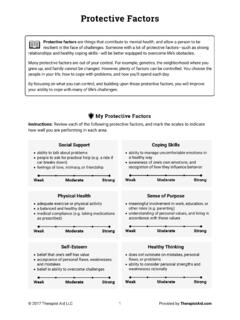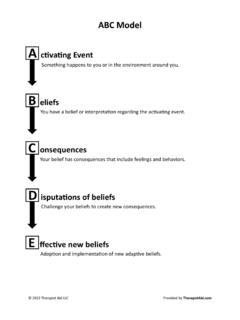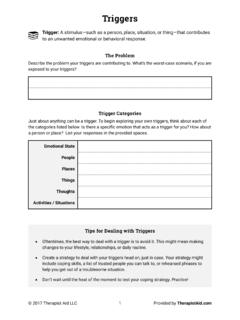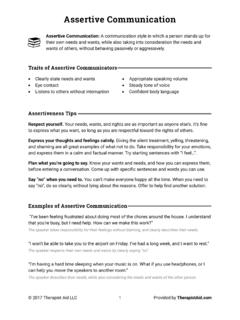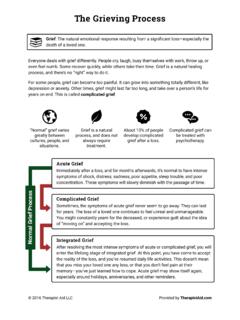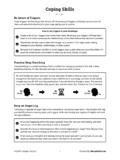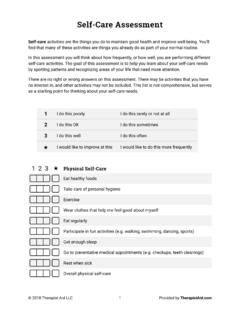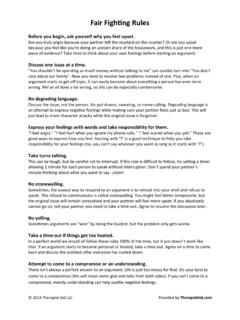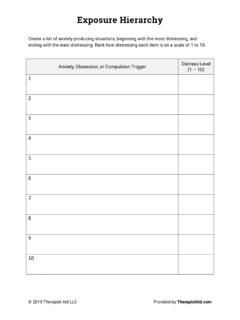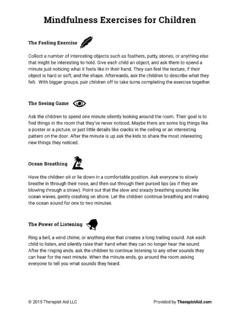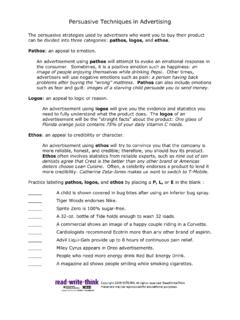Transcription of Family Mindfulness Schedule - Therapist Aid
1 Family Mindfulness Schedule Mindfulness , simply put, is being focused on the present moment. This skill improves emotional awareness and reduces stress. A parent can help their child achieve Mindfulness by modeling Mindfulness themselves, or by teaching their child to focus on the present moment. Below you will find Mindfulness techniques you can practice with your child during a busy daily routine. Focus on doing one technique very well each day, rather than trying to do many. Waking Up Five Senses. With your child, take a few moments to explore the morning through your senses. Take turns naming things you see, hear, feel, taste, and smell.
2 Try to notice things you would normally tune out, like the distant buzz of a neighbor's lawnmower, or the softness of a pillow. Body Scan. Starting with your toes and working your way up to the top of your head, notice the sensations in each part of your body. For example, notice the feeling of clothing resting on your legs, tension in your muscles, or cool air on your face. Meals Mindful Check-In. Start a conversation about the here-and-now by asking your child to share one thing they are feeling physically, one thing they are thinking about, and one thing they are feeling emotionally. If your child has difficulty putting their emotions into words, try giving them options to choose from.
3 Mindful Eating. Rather than rushing through a meal, eat slowly and mindfully. Notice how the food looks, and how it smells. What does it taste like? What does the food feel like on your tongue? Take turns sharing different things you notice about the food, no matter how minor the observations might seem. Travel I Spy. In this game, your child will spy a color they see and ask you to guess what the object is. Playing this game will allow your child to take in their surroundings and notice things they might otherwise miss. The Alphabet Game. While driving, ask your child to look for words in their environment beginning with each letter of the alphabet, in order.
4 For example, a billboard with the word Advertise would start the game. School Mindfulness Bracelet. With your child, spend an afternoon making bracelets that are fun, and comfortable to wear. Every time you notice the bracelet on your wrist, take a moment to note one thing you see, hear, smell, and feel. Practice at home to get your child in the habit of using this skill even when they are not with you. 2018 Therapist Aid LLC 1 Provided by Family Mindfulness Schedule Square Breathing. Teach your child this breathing technique to help them be in the present moment at any time. Draw a square on paper, or in the air with your finger.
5 Perform one step of the technique while drawing each line of the square. Time each step to last about four seconds. Free Time Mindfulness Box. With your child, decorate a box large enough to hold several small objects. Fill the box with interesting items found around your home and yard ( feathers, rocks, flowers). Encourage your child to explore their surroundings with more than just sight. For example, notice the texture, weight, and smell of each item. Keep adding to your Mindfulness box, and review it from time to time for further practice. Try to notice something new about each of the objects inside. Bedtime Progressive Muscle Relaxation.
6 This activity will help your child become aware of the sensations throughout their body, and it's a great way to begin relaxing the body for sleep. Read the following script slowly, allowing time for practice. Close your eyes, and pretend that you're holding two juicy oranges one in each hand. Start to squeeze the oranges by making fists. Squeeze hard to get all the juice out. Notice what your fists feel like when you squeeze hard. Now let go of the oranges, and let your hands rest. Notice how good it feels to relax your hands. Next, pretend like you're sitting on the beach. Squeeze your toes as if you are trying to pick up sand between them.
7 Hold onto the sand by squeezing even tighter. Now, let go of the sand, and relax your feet. Notice how your feet feel different when you let them rest. Finally, pretend like a fly landed on your nose. You want to get it off, without touching it with your hands. Scrunch up your face, wiggle your nose, just go crazy! Keep moving your face so the bug will fly away. Now, stop, and let your whole face relax. Pay attention to how it feels. 2018 Therapist Aid LLC 2 Provided by
